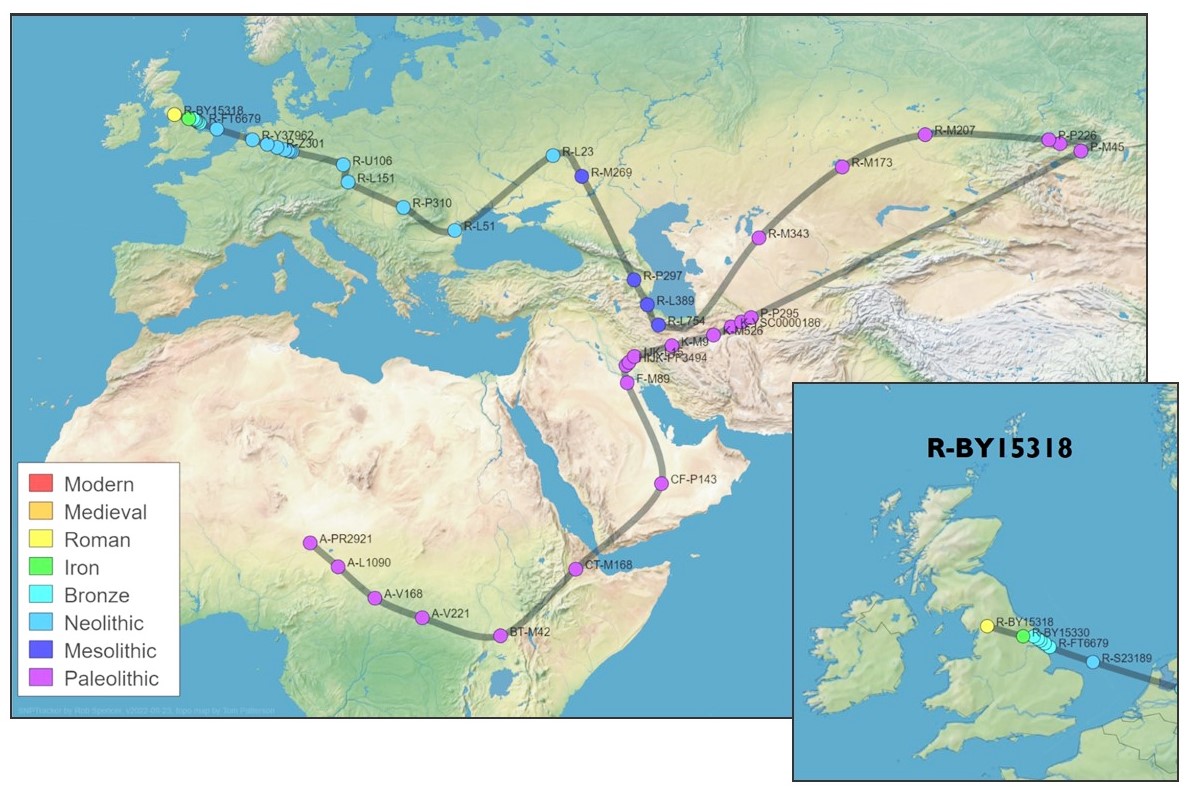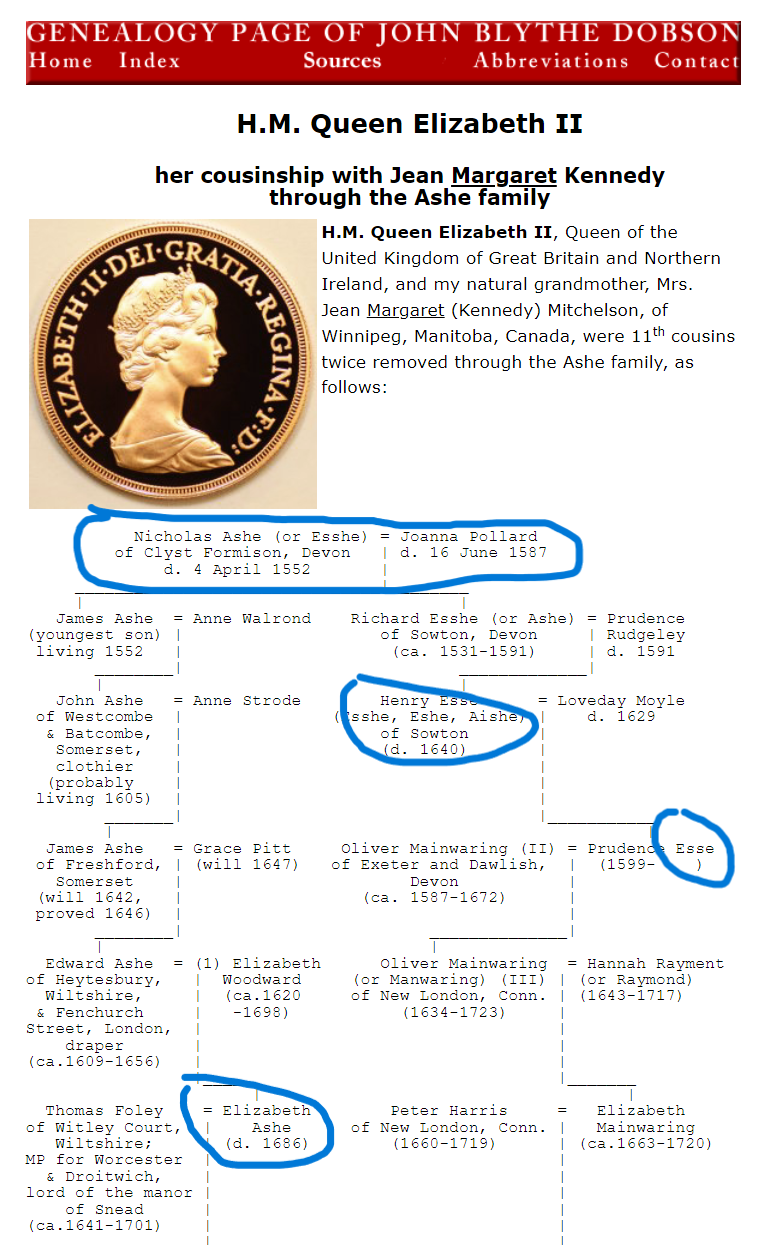Great news! We now have a BigY Test Result for the Direct Paternal Line of Henry Ashe (~1798) (m. Mary “Polly” Murphy).
UPDATE (July 20, 2023): We now have 3 BigY results for this Ashe line. After I analyze the current results along with autosomal DNA matches, I will follow up with more information.
After 9 years of searching for a BigY tester for this line, we finally have one! For those who are not familiar with Y-DNA testing, in brief, a Y-DNA test is for testing a male’s direct paternal line of descent (his father’s father’s father’s line). The value of Y-DNA testing, in my own words, is that the results are more of a “sure thing.” In contrast, using only autosomal DNA (atDNA) matches, i.e., Ancestry, to break through more distant brick walls is more difficult since atDNA is randomly inherited from our ancestors. That means it can be difficult to determine from which ancestral line we inherited a DNA segment, and this is especially true if we share multiple ancestors with a DNA match. For this reason, I seek out Y-DNA candidates whenever possible. With a Y-DNA match we know that the shared DNA between two or more males is on the Y-line, and the results show the common ancestral line going back thousands of years. So, it’s understandable why Y-DNA testing may be extremely helpful in resolving a brick wall on the Y line. This is especially true if the brick wall in question is in the 4th-6th cousin range or even further back in time. The most advanced level of Y-DNA testing at Family Tree DNA (FTDNA), BigY, is what gives us this useful information, and it is really gaining in popularity.
The current BigY results for our Ashe cousin are also beneficial for other Ashe cousins who descend from Henry Ashe as well as for those who are more distant Ash(e) cousins. Specific to Henry Ashe, though, if you are reading this you are likely aware that Henry’s father is unknown. Yes, I’ve seen some trees on Ancestry that have theories regarding Henry’s father, but I think some of the information associated with those possibilities does not add up. Thankfully, now that we have a BigY test result AND a well-documented line back to Henry, I will spend more time researching this Ashe line and try to find and “prove” the connections to the other Ash(e) lines.
Much to my surprise, when I received my cousin’s BigY results there were already three other test results at the Y-12, Y-37, and Y-67 levels. I contacted the kit managers and encouraged these gentlemen to upgrade their results to the BigY level. One tester was deceased, and at this time I have not seen any other upgraded test results. But, today, I logged in and there was a brand new Y-37 test result! This Ashe cousin descends from a different Ash(e) line, so we may be able to answer a few more questions in due time. Hopefully, he will upgrade his results to BigY. Those results would be very useful to our efforts since this line represents a more distant connection or kinship way beyond Henry Ashe (1798 SC).
I hope all the lower level Y testers will upgrade to the BigY test because at this point, I still think we need to evaluate as many SNP results and maybe extended STR values as possible to resolve these brick walls. But, for now, I can say this:
- The direct paternal line of Henry Ashe (~1798) is of English origin and not of an Irish one.
- I believe the older generations thought our Ash(e) lines were of Irish origins because there are some Ash(e) families who migrated to Ireland from England, stayed a while, and then moved to Pennsylvania or elsewhere in the USA, and eventually making their way to York County, South Carolina. I assume that the older generations remembered stories of distant cousins living in or coming from Ireland. So, their assumptions were certainly understandable. But, again, our direct paternal Ash(e) ancestors were of English origins even though some had lived in Ireland.
- This Ashe line does not descend from the German Oesch/Esch lines. Let’s just say, not in modern times, but perhaps there is a deeper ancestral connection. At this time, I do not know.
- This Ashe line may very well be connected to that of the late Queen Elizabeth II. Preliminary findings indicate that this could be true. But, again, we need more Y-DNA testers to help solidify this theory. Whatever the case, below is an image of the Ash(e) / Esse lines in Queen Elizabeth’s ancestry.
- We have several other BigY matches to my Ashe cousin’s BigY test result. The common ancestor between all the BigY testers is likely to have been born around 850 CE (range: 470 CE – 1140 CE). So, that’s a tremendous gap of unknowns between possibly 470 and when Henry Ashe was born in ~1798. HAVING MORE BIGY RESULTS CAN FILL IN THESE GAPS BETWEEN OUR RELATED ASH(E) LINES AND TO THE OTHER BIGY LINES / RESULTS. PLEASE CONSIDER UPGRADING YOUR CURRENT RESULTS, TESTING YOURSELF (if qualified), OR HELPING TO FIND OTHER QUALIFIED MALE ASH(E) COUSINS WHO WOULD BE WILLING TO TAKE A BIGY TEST. I WOULD BE HAPPY TO CONTRIBUTE TO THE COSTS. By the way, having cousins contribute to the cost of a Y-DNA or BigY test and/or an upgrade is a common practice since so many descendants benefit from the results.
- The other BigY testers who match our current Ashe cousin’s BigY results are all born in England and their direct paternal ancestry is English. This provides more DNA evidence that our Ashe line is English and not Irish.
Well, that’s a lot of information to learn from one BigY test result! Imagine if we had more….
We still have a lot of work to do, and with more results, my thinking on any of these points will adjust to some degree. In the meantime, I will start to pull together old and new research and add more information here when I can. But, before I leave you, here are some interesting graphics, we have so far, about the direct male paternal line of Henry Ashe (1798) m. Mary “Polly” Murphy and the deeper ancestry of this shared Ash(e) line.
Haplogroup Story

Notable Connections

Current Haplogroup and SNP Path
This is the current Haplogroup, R-BY15318, and SNP path for the line of Henry Ashe (~1798). It shows the path our shared male Ash(e) ancestors took, walking through time, from long ago to England. This Haplogroup formed about 850 CE. A BigY test, not an STR test (Y-111, Y-67, Y-37, Y-12) provided this information. Additional BigY tests would bring this path and results into modern times and provide more information about our related Ash(s) lines.

Ancient Connections

Ashe and Esse Lines in the Ancestry of Queen Elizabeth II

To see the entire image, more information, and sources, go to: https://johnblythedobson.org/genealogy/famous/England.html
Basic Y-DNA Findings

Ok, that’s all for now. I will work on this information. I welcome genuine collaboration and feel free to email me with suggestions, additions, comments, or questions.
Again, it would be very helpful if these current testers upgraded to the BigY level of Y-DNA testing. But, since that is not always possible, please help in finding other qualified male Ash(e) cousins to take a BigY test which would provide the needed SNP data. In many cases, the SNP results are more reliable than the STR values, and it would be great to have them so we can have more refined results for comparison between the various Ash(e) lines. And, don’t forget, we also need well-documented paper trail(s). The BigY results could help pinpoint where to look for traditional genealogical documents to determine who is the father of Henry Ashe and his exact line back to England. The same strategy applies to all the Ash(e) lines. Having both DNA evidence and a solid paper trail for each line helps to create a genetic profile and a well documented history of our shared Ash(e) ancestry.
Thank you, in advance, for your help and any future input you can provide.
Best,
Julia
Julia Ashe Wannamaker
JuliaWannamaker@gmail.com
http://www.WannamakerGenealogy.com
Posted: January 24, 2023
NOTE:
For additional and in depth information about BigY testing and results, please join Bill Wood’s Facebook group Bill created this FB group several years ago for the purpose of helping users to better understand their BigY results. The group is filled with experts, novices, and advanced amateurs, and many are willing to provide great advice and assistance. Learning more about the application of BigY results on this site can help you make decisions about taking the BigY test and ordering upgrades. A great beginning is to read the highly recommended file, “The Rule of Three.”
January 28, 2023